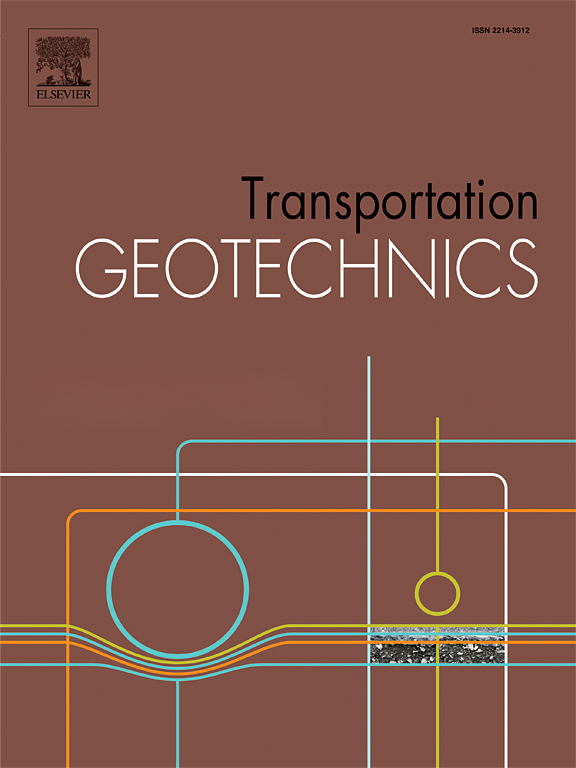Field measurements at a road embankment during a winter season in northern Sweden
IF 5.5
2区 工程技术
Q1 ENGINEERING, CIVIL
引用次数: 0
Abstract
Understanding the thermal regime of road embankments in cold climates during winter is essential for efficient road design and accurate estimation of maintenance frequencies to reduce freeze-induced damage. In response to the challenging climate conditions in northern Sweden, an experimental field setup was designed to assess the thermal impact of culverts and accumulated snow in ditches on the thermal regime of road embankments during a winter season. This study provides detailed information on the experimental setup, highlights potential challenges from installation phase to data acquisition, and addresses measurement errors. Methods to ensure accuracy and obtain reliable data are also presented. Additionally, some of the obtained measurement results are included in this paper. The results show that snow impacts the thermal regime of the embankment from the onset of accumulation in the ditch, when the snow cover is still thin, until it reaches a depth of 65 cm. Beyond this depth, the soil beneath the snow remains almost unfrozen throughout the winter season. Additionally, the temperature distribution measurements within the embankment indicate that freezing progresses faster near the culvert compared to the rest of the embankment. However, once the culvert ends are insulated by snow cover, the frost depth in the soil near the culvert does not increase significantly, while the rest of the road continues to freeze gradually to greater depths throughout the winter season. The measurement results presented in this study provide researchers with a reliable dataset for validating numerical models in related research areas simulating cold-climate conditions. Additionally, these results enhance the understanding of the thermal regime of road embankments in typical cold climates and offer valuable insights for planning road maintenance and construction in such regions. Furthermore, this study provides essential information for researchers aiming to design and optimize experimental measurement setups in similar investigations.
冬季在瑞典北部的道路路基上进行实地测量
了解冬季寒冷气候下路堤的热状态对于有效的道路设计和准确估计维护频率以减少冻害至关重要。为了应对瑞典北部具有挑战性的气候条件,设计了一个试验田设置,以评估冬季涵洞和沟渠中积雪对路堤热状态的热影响。本研究提供了实验设置的详细信息,强调了从安装阶段到数据采集的潜在挑战,并解决了测量误差。文中还提出了保证准确性和获得可靠数据的方法。此外,本文还包括了部分得到的测量结果。结果表明:积雪对路堤热态的影响始于积雪覆盖较薄时的沟槽堆积,直至积雪覆盖深度达到65 cm;在这个深度之外,雪下的土壤在整个冬季几乎保持不冻状态。此外,路堤内的温度分布测量表明,与路堤的其他部分相比,涵洞附近的冻结速度更快。然而,一旦涵洞末端被雪覆盖,涵洞附近土壤中的霜深度不会显著增加,而道路的其余部分在整个冬季继续逐渐冻结到更大的深度。本研究的测量结果为相关研究领域模拟寒冷气候条件的数值模式的验证提供了可靠的数据集。此外,这些结果增强了对典型寒冷气候下道路路堤热状态的理解,并为这些地区的道路维护和建设规划提供了有价值的见解。此外,该研究为研究人员在类似研究中设计和优化实验测量装置提供了必要的信息。
本文章由计算机程序翻译,如有差异,请以英文原文为准。
求助全文
约1分钟内获得全文
求助全文
来源期刊

Transportation Geotechnics
Social Sciences-Transportation
CiteScore
8.10
自引率
11.30%
发文量
194
审稿时长
51 days
期刊介绍:
Transportation Geotechnics is a journal dedicated to publishing high-quality, theoretical, and applied papers that cover all facets of geotechnics for transportation infrastructure such as roads, highways, railways, underground railways, airfields, and waterways. The journal places a special emphasis on case studies that present original work relevant to the sustainable construction of transportation infrastructure. The scope of topics it addresses includes the geotechnical properties of geomaterials for sustainable and rational design and construction, the behavior of compacted and stabilized geomaterials, the use of geosynthetics and reinforcement in constructed layers and interlayers, ground improvement and slope stability for transportation infrastructures, compaction technology and management, maintenance technology, the impact of climate, embankments for highways and high-speed trains, transition zones, dredging, underwater geotechnics for infrastructure purposes, and the modeling of multi-layered structures and supporting ground under dynamic and repeated loads.
 求助内容:
求助内容: 应助结果提醒方式:
应助结果提醒方式:


